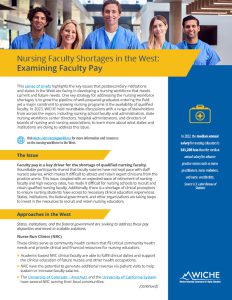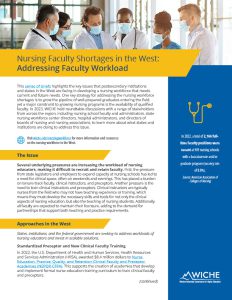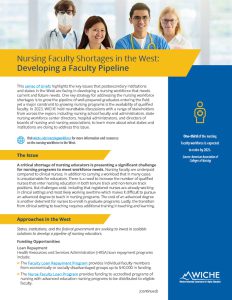Nursing Faculty Shortages
One key strategy for addressing nursing workforce shortages is to grow the pipeline of well-prepared graduates entering the field, yet a major constraint to growing nursing programs is the availability of qualified faculty.
Defining the Different Types of Nursing Faculty and Educators
These briefs discuss various roles within the field of nursing faculty and education. For the purpose of these briefs, we discuss tenure track and non-tenure track faculty, as well as preceptors.
Tenure Track: Doctorate-educated faculty who have requirement of teaching, scholarship, and service. Titles include Assistant Professor, Associate Professor, Professor.
Non-Tenure Track: Most have a master’s in science in Nursing (MSN) degree, some with a doctorate of nursing practice (DNP) degree or a PhD, depending on university/program. Most often are involved in clinical teaching with less scholarship, service and leadership roles. These positions typically require an active RN license. Sample titles include Clinical Instructors, Lecturers, or Adjunct.
Preceptors: Although preceptors are typically employed outside of the academic institution, given the key role they play in student learning and teaching they are discussed in the context of these briefs. Preceptors are experienced licensed clinicians who serve the teachers for students in their clinical rotations.
Issue Briefs
This series of briefs highlight the challenges that institutions and states in the West are facing in recruiting and retaining qualified nursing faculty and clinical preceptors and highlights the strategies that states, institutions, and the federal government are implementing to address these challenges. Several key issues were described by roundtable participants related to the ability to recruit and retain nursing faculty, such as the pay disparity between nursing faculty and staff nurses, the workload of nursing educators, limited clinical preceptors, and the ability to develop the pipeline of future nursing educators.
The examples and strategies shared in these briefs, in addition to other examples from across the West and the nation, can be found on the Resources page.

Examining Faculty Pay
August 24, 2023
The median annual salary of nursing educators is more than $40,000 less than the median salary of advanced practice nurses. This wide pay disparity presents a challenge in the recruitment and retention of well-qualified nursing educators. This brief focuses on strategies that institutions, states, and the federal government are implementing to address pay disparities and invest in scalable solutions.
Download PDF
Addressing Faculty Workload
August 24, 2023
With a vacancy rate of nearly 9%, colleges of nursing are facing a challenge in recruiting and retaining nursing faculty. In addition to pay disparities, experts from the field note that the workload of nursing faculty serves as a key challenge in retaining faculty. This brief highlights the ways that states, institutions, and the federal government are seeking to address workloads of nursing educators and invest in scalable solutions.
Download PDF
Developing a Nursing Pipeline
August 24, 2023
It is projected that one-third of the nursing faculty workforce will retire by 2025, which means that nursing schools feel pressure to not only educate the next generation of nurses but also developing a nurse educator pipeline that will fill the expected openings. This brief highlights the ways that states, institutions, and the federal government are seeking to invest in scalable solutions to develop a pipeline of nursing educators.
Download PDF